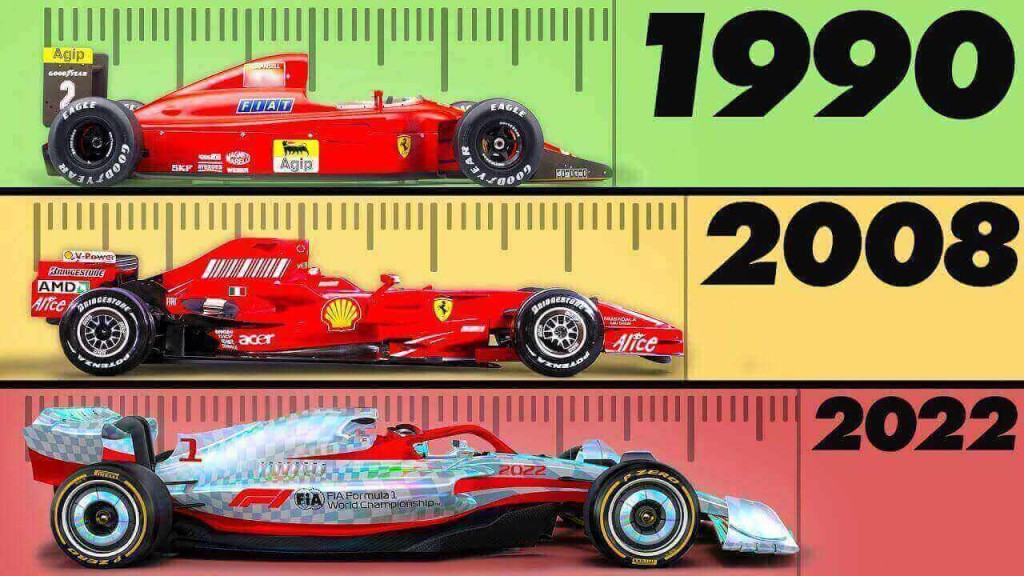Perhaps you’ve wondered how much does an F1 car weigh after seeing the newer, bigger, and meaner racing machines here to astound us during the 2022 season.
You’ve guessed it: They’ve indeed added some winter weight for a total minimum of 798 kg!
But why are all these changes made, and how much do individual components weigh?
Find out below!
How Heavy Are F1 Cars?

The 2022 F1 cars are the heaviest they have ever been, resulting from the constant addition of security features with the goal of making the sport safer and more exciting.
For instance, the F1 halo added 9 kg to the overall car weight (initially 7 kg) after it was implemented due to Jules Bianchi’s horrific crash at the 2014 Suzuka race.
However, despite its initial controversy, the halo has saved and will save numerous lives.
The F1 car weight for 2022 must be at least 798 kg (per FIA regulations), which is an increase of 46 kg from the previous season, and it all comes down to the new technical rules set to facilitate better racing through ground effect and weightier 18-inch tyres.
Since every team wants to have lighter cars for maximum performance, most of them are close to this limit; therefore, we can comfortably say F1 cars are only slightly overweight to about 800 kg. Still less than your average road car—1,200 kg in a smaller package!
Note: The total weight must include 80 kg of ‘seat weight’, which consists of the driver and his equipment, and the car must be fitted with a dry-weather tyre set and emptied of fuel. Cars that fail the weighbridge test will receive a harsh penalty.
Also read: How long is a Formula 1 race?
How Much Do F1 Parts Weigh?
So how much does each component contribute towards the total weight of an F1 car?
The following list includes the individual mass of several major parts listed from lightest to heaviest and whether or not they have any weight requirement:
| Part | Weight |
| Steering wheel | Around 1.3 kg |
| Halo | Exactly 9 kg |
| Front wing | Around 10 kg |
| Set of tires | Around 21 kg |
| Gearbox | Around 40 kg |
| Chassis | Around 100 kg but has no set weight |
| Power unit | Minimum of 150 kg |
The table and the FIA regulations do not include the total fuel load of 110 kg, which means that a car with a full tank will weigh at least 908 kg at the start of a Grand Prix.
If you want to learn just how much all of the above components cost, head on to our thorough guide breaking down the price of a modern F1 car.
Also read: Who is the greatest F1 driver?
F1 Car Weight Over the Years
Older fans remember that F1 cars were much leaner and lighter in previous seasons, albeit at the expense of safety. The following list shows their weight evolution over the years:
| Year | Weight | Significant Changes |
| 1950–1960 | No limit | Not applicable |
| 1961–1965 | 450 kg | First weight limit regulations |
| 1966–1969 | 500 kg | Mid-engine car used |
| 1970 | 530 kg | 3L V8 double four valve engine used |
| 1972 | 550 kg | Added: fuel tank safety foam, magnesium sheeting, headrest, rear lights, and more |
| 1973–1981 | 575 kg | Safety bladder fuel cell tanks and crushable structure around them made mandatory |
| 1982 | 580 kg | Skirts and ride height legalized |
| 1983–1986 | 540 kg | Ground effect and 4W-drive banned |
| 1987–1990 | 500 kg | Survival cell and fuel cell made mandatory |
| 1991–1993 | 505 kg | Changes to the rollbar, fuel tanks, seat belts, and survival cells |
| 1994 | 515 kg | Certain headrest changes |
| 1995 | 495 kg | Reduction in engine capacity and introduction of inch safety straps |
| 1996–2002 | 600 kg | Accident data recorder, wheel tethers, V10 engines, and traction control added |
| 2003-08 | 605 kg | HANS device made mandatory |
| 2009 | 605 kg | Introduction of KERS |
| 2010 | 620 kg | Refuelling was banned |
| 2011–12 | 640 kg | KERS is reintroduced |
| 2013 | 642 kg | Modesty panels added |
| 2014 | 690 kg | Hybrid V6 engines introduced |
| 2015–16 | 702 kg | Redesign of the nose |
| 2017 | 728kg | Wider car and wheels width, larger barge boards, and shark fins brought back |
| 2018 | 733 kg | Introduction of the halo device |
| 2019 | 740 kg | Seat weight allowance for drivers |
| 2020 | 746 kg | Added a second fuel flow meter |
| 2021 | 752 kg | Heavier standard parts |
| 2022 | 798 kg | New design focusing on ground effect with a bigger power unit, front wing, wheels, and wheel caps |
With the increase in weight, F1 engineers also had to design more powerful engines to maintain the same blistering speeds, a topic covered in depth in our F1 car horsepower guide.
Also read: Formula 1 facts and statistics
How Long Is an F1 Car

What about the length of a Formula 1 car then? How did its size change along with its weight?
Similar to their weight increase, the physical dimensions of F1 cars have also grown over the years, from a length of about 3.6 meters in the 1960s to around 5.5 meters in 2022.
The Formula 1 car length even reached 5.7 meters in 2021, a record held by that year’s Mercedes design, which decreased due to the new aerodynamic regulations.
Note: While F1 regulations state that cars cannot be wider than 200 cm and taller than 95 cm, there are no such rules about length. However, since F1 rules restrict the size of other car components, the difference between the shortest and the longest car is around 20 cm.
Bottom Line
Driven by innovations and system changes to improve the sport’s safety, the Formula 1 car weight has been rising steadily since its inception.
From the flimsy 400kg tin cans of the 1950s, we have moved on to the curvy yet speedy F1 machines of the 2020s that weigh double that without a drop of fuel in them. In all likelihood, we are never going back!
FAQs:
How much does the average F1 driver weigh?
While the average weight across all 20 drivers on the grid is 68 kg, the car’s total weight must include a minimum seat weight of 80 kg (which includes the F1 driver); therefore, lighter drivers use ballasts to make up the difference.
Are all F1 cars the same length?
Since the FIA does not impose strict requirements regarding the car length, the models of different constructors may vary slightly. While the Red Bull, McLaren, and Williams cars are the shortest at 5.4 meters, the Alpine is the longest at 5.62 meters.
Why are F1 cars getting bigger?
Formula 1 cars are consistently increasing in size and weight due to the evolving safety regulations that include various features like the halo and the HANS device; moreover, larger cars can withstand significantly worse impacts.
How much does an F1 car weigh with a full tank?
Since the average weight of F1 cars is around 800 kg and a full tank comes up to 110 kg, these racing machines often start a race weighing approximately 910 kg.

